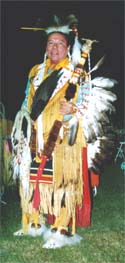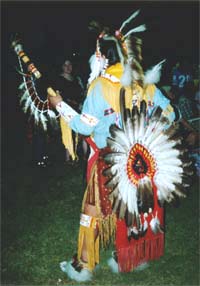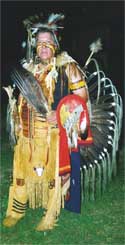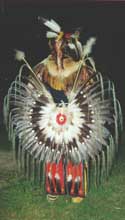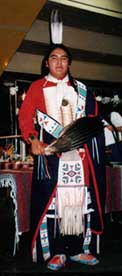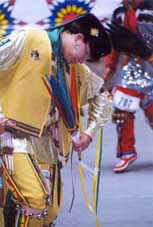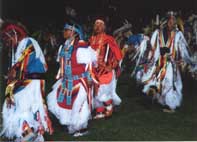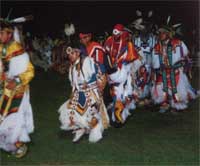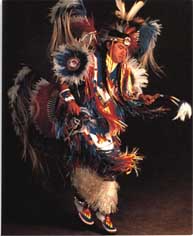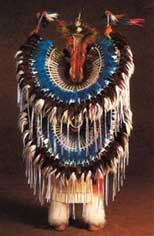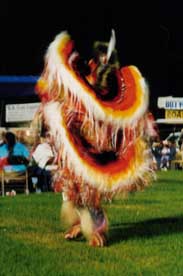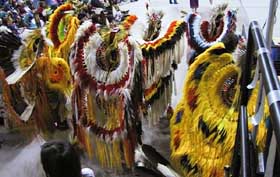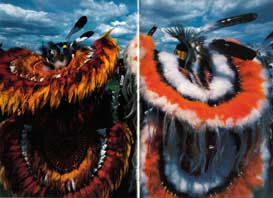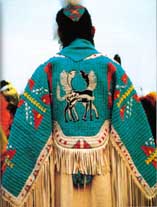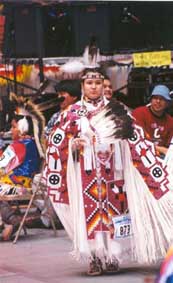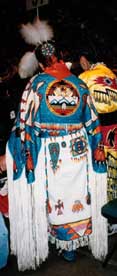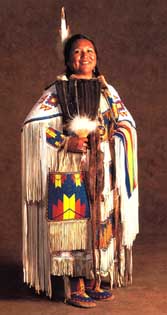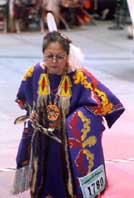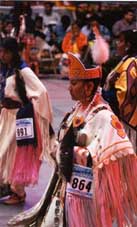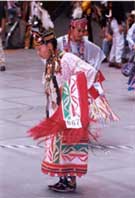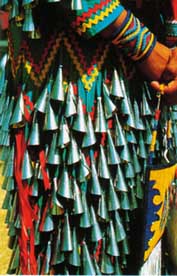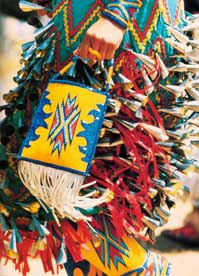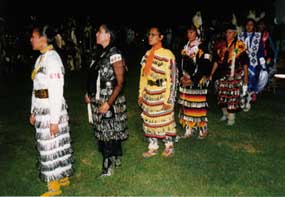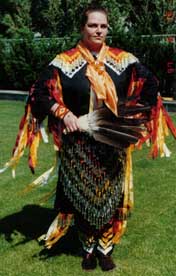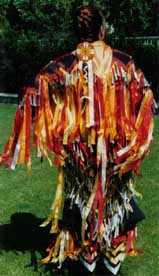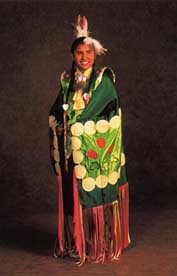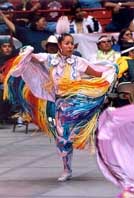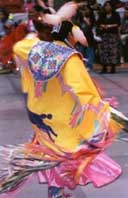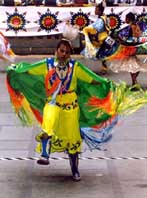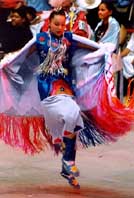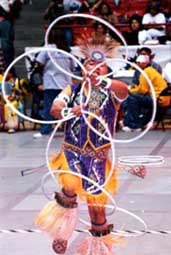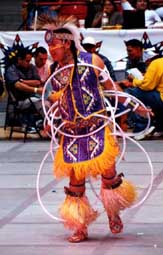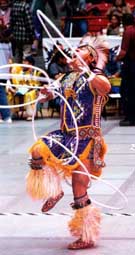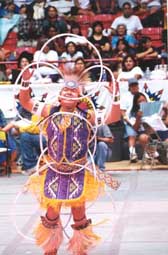9.
What is Pow Wow?
 A
Pow Wow is
an
experience!
A
Pow Wow is
an
experience!

Each
year, from spring to fall, there are gatherings, so called Pow Wows.
Native American peoples from across the United States come together to celebrate
their traditions, their connections to Mother Earth and to one another.
For the hundreds of Native
American nations it is more than an hommage to a wonderful ancestry but an
event of contemporary significance.
The
term POW WOW is traced to the Algonquin language (like the Delaware
or Huron). In the Lakota/Dakota language it was called "Wacipi".
This was originally an event in spring to celebrate the seasonal renewal of
life. People would come together to dance, sing, meet old friends and eventually
find new friends.
Usually
a Pow Wow starts on a Friday afternoon and ends at Sunday in the evening.
ALCOHOL
is STRICTLY FORBIDDEN!
The area
is outside of a town and in the center is the arena. Around the arena are
the tents, tipis and trailers of the participants, together with the stalls
of traders and artists.
The arrangement
shows, that an important symbol to Native American people is found
everywhere in pow wows: the CIRCLE!
In the center of the arena are the dancers, around them are the drums and
the audience.
The
circle is a symbol for continuity. It brings the circle of people closer to
family.
From some
distance you can hear the sound of the drums as well as feel its deep vibrations.
It feels like being drawn towards it. Then you hear a single voice very high,
followed by the choir. The begin of the Grand Entry .......
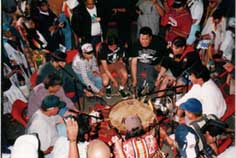
The MC
(Master of Ceremony) calls the dancers into the arena. Sometimes he also tells
stories or jokes.
First
the flags are carried into the arena by a so called HONOR GUARD, consisting
of veterans: the Eagle Staff, followed by the American, state and tribal flags.
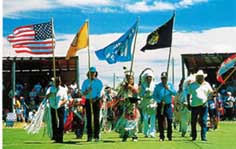
After
the veterans the Head Man Dancer and the Head Lady Dancer enter
the arena followed by all the other dancers: men, women and children.
The two dancers who hold the higly regarded positions guide the other dancers
through the arena.
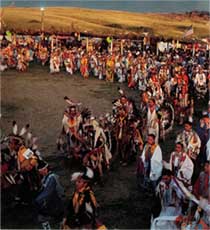
After
the entry into the arena, which can last up to an hour or more depending on
how many dancers are joining the pow wow, a flag song is performed,
while the honor guard moves towards the center of the arena to place the flags
to the pole in the center.
A flag
song is an equal to a National Anthem and every tribe has its own. While the
flag song is performed, everyone stands and has to be silent to give the proper
respect.
There
are several other types of songs: honor song, veteran songs, war party songs,
songs for grand entries and those for dance categories.

A
dropped Eaglefeather
The eaglefeather
is sacred to Native Americans, due to its connection with the sky.
If one
falls down from the outfit of a dancer, the pow wow stops. Four traditional
dancer (usually veterans) perform a ritual to restore the lost power of the
feather. They dance around the feather from the four directions and attack
four times to retrieve it.
During
this ritual spectators stand with their heads uncovered and it is not permitted
to take any pictures.

The
Give-Away
The Give-Away
is completely different to the way of thinking in our society.
We expect
gifts for accomplishments. The Native American society is completely different:
the person being honored should provide gifts. It is said, that the Chief
usually was the poorest man. He was honored by his people and he gave away
food, horses and blankets, or whatever they might need.
Nowadays
the giveaways are very common at a powwow. The are prepared on many occasions,
like college diploma or university diploma or a round birthday. The reasons
a various.
The "Giver"
shows his pride through the amount and the value of the gifts. The family
members are in the middle of this zeremonie and give their gifts to friends
and relatives of the honored person.
During
the give-away an announcer explains the reasons for this give-away and calls
up the people to receive their gifts.

The
Dances
9.1.
Men's Traditional
9.2. Men's Grass
9.3. Men's Fancy
9.4.
Women's Traditional
9.5. Women's Jingle
9.6. Women's Fancy Shawl
9.7.
Hoop Dance
9.8. Intertribal
9.1.
Men's Traditional

Northern
Style
Background:
This dance is said to begin with war parties and hunters returning back to
their village and describing their story of the battle or tracking prey.
The outfit
is often decorated with beadwork or quill and subdued in color. Shields, medicine
wheels, honor staffs and a fan are also part of the outfit as well as a bustle.
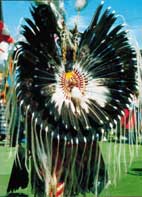 example for a
bustle, (c) M.Dixon, V.Krasemann
example for a
bustle, (c) M.Dixon, V.Krasemann
The bustle
is the most impressive part. It is made of eaglefeathers or feathers from
other birds of prey. The spread out feathers of mating birds are taken as
example for the bustles.
Two fans made of eaglefeathers form the circle of the bustle. The ring has
about one meter in diameter. The two longer feathers on the top pointing upwards
(the spikes) symbolize the channel between the things on earth and
the Great Spirit.
The feathers are often decorated with strands of horsehair, symbolizing the
scalps of the killed enemies.
Another
important part of the outfit is the roach (headgear). The eaglefeathers
(spinners) embedded in it transfer the power of the eagle to the dancer
and honors the eagle in the same way.
Other
parts, that belong to this kind of outfit are moccasins (fully beaded or painted),
leggins (either buckskin or linnen), a breastplate and other things like fur
capes (optional).
When the
dancers move, they bring every single part from their outfit into motion.
They still describe hunting or fighting scenes with their movements (especially
in the Sneak up - Song).
For a special dance they imitate the movements of the crows (Crow Hop).
Sometimes
the regalia of the dancers include a read eagle feather. This denotes a veteran
who was injured in a battle. The spectators then stand up and remove their
hats to honor the dancer.
Some of
the outfits, or parts of them, were handed down for generations.
| |
|
|
|
| Ken
Brown
Lakota - Cree |
Ken
Brown
Lakota - Cree |
Bruce
Brown
Lakota - Cree |
Bruce
Brown
Lakota - Cree |
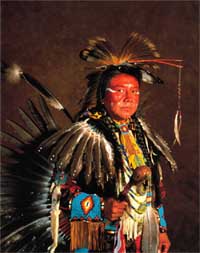 (c) Ben Marra - www.benmarra.com
(c) Ben Marra - www.benmarra.com
Francis
J. Cullooyah, T-Shel-Shu-Lex (Stands on The
Ground), Kalispel / Flathead
Southern
Straight
Background:
The dance is similair to the Northern Style. Except the outfit is different.
The dancers usually wear a shirt, breastplate and pants made of either buckskin
or cotton together with a fan but no bustle.

9.2.
Men's Grass

Background:
There is a legend to this dance:
A young man was lame in one foot. He longed very much to dance. One day he
went to the prairie to pray for guidance. He limped up a small hill and on
the top of that hill, something told him to create his own dance style. Looking
down on the swaying grass of the prairie, he realized this could be his dance.
So he started dancing,
moving like the grass in the wind.
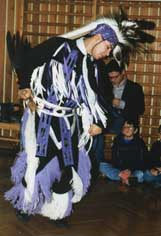
Other
explanations are also found, like this dance was used as the beginning of
ceremonies, to "dance down" the grass, so that the participants
could sit comfortably.
When you
look at the outfit of a moving grass dancer, you will notice the strands of
wool or ribbons (originally grass was tucked into the belts). Also the dancers
keep moving their heads up and down with the beat of the drum. This keeps
the feathers in the roach spinning, which is a sign of a good dancer.

9.3.
Men's Fancy Dance

Background:
This dance style is relatively new and has its roots in the dances performed
before a war party left the village. They danced for good fortune and the
honor to fight as well as an honorable death.
The most
striking part of a fancy dance outfit is the colorful bustle. Actually there
are two bustles carried on the back and sometimes two smaller bustles carried
on the upper arms or the shoulders.
This dance
style is marked with fancy footwork, acrobatic steps, varied body movements
and increased speed. Most important is that the dancers must follow the changing
beat of the drum. When the music stops the dancers have to stop with both
feet on the ground.
| |
|
| Michael
Roberts, Dancing Eagle Feathers,
Choctaw / Chickasaw |
Michael
Roberts, Dancing Eagle Feathers,
Choctaw / Chickasaw |
| (c)
Ben Marra - www.benmarra.com |
(c)
Ben Marra - www.benmarra.com |
Here are
some more samples of Fancy Dancers.

9.4.
Women's Traditional Dance

Northern
Buckskin Style:
Background:
Women were never allowed to dance, like the men did. They were just standing
around the arena or behind the drumgroup and moving slightly up and down,
while expressing pride. It is also said, that the up and down movement also
symbolizes women gazing into the distance and awaiting their warriors to return
home.
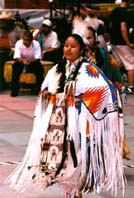 (c) Gathering of Nations www.gatheringofnations.com
(c) Gathering of Nations www.gatheringofnations.com
It
is an elegant, slow, graceful walk and involves a slow moving-bouncing step,
rhythmically dipping and swaying to the beat of the drum. Some dancers dance
in place, on their toes, bending at the knees and bouncing slightly. Very
important is the rising of the fan for the honor beats of the drum.
The dress is made of buckskin. Most of the yokes are fully beaded. But you
also find some decorated with quill, bone, teeth or shells. The colors used
tend to be softer than jingle or fancy shawl dance and may have symbolistic
meaning to tribal traditions.
From
the yoke of the dress are hanging long fringes, which sway to the rhythm of
the drum. Beaded leggins and moccasins belong to the dress as well as a belt
with pouches for awl, flintstone and knife. A beaded strap is also hanging
from the belt and symbolizes a horsewhip.
Very
important is a fan made of eaglefeathers, a long breastplate made of bone
hairpipes and glass beads, as well as a shawl which you carry folded over
your arm. Optional is a purse and a choker or jewelry.
Southern
Buckskin Style:
Background:
The dancing steps are basically the same as for the northern buckskin. But
the outfit differs!
The
dress is also made of buckskin but the yoke is not fully beaded as in Northern
Buckskin Style. It is decorated with beaded accents all over. Some have beaded
strips on the shoulders.
You have the same accessories as for the Northern Buckskin. But the breastplate
is shorter.
Also
the dance is a little different. The music is a little slower and at the honor
beats the dancers bow at the waist.
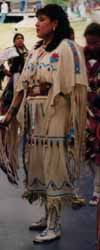
Southern
Cloth Style:
Background:
The dancing steps are basically the same as for the northern buckskin. But
the outfit differs!
The
dress is made of cloth, decorated with ribbons, beadwork or silverwork.
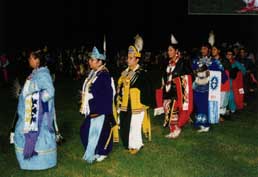
A
shawl is very important. The outfit may also include a purse, breastplate
and a fan.

9.5.
Women's Jingle Dance

Background:
This dance style has a very nice legend:
A man
was seeking healing for his sick daughter. In a vision he saw the girl dancing
in a dress he'd never seen before. The dress was decorated with many small
bones. At each step the bones were colliding with each other and making a
very distinctive sound.
In this vision he learned, that his doughter should dance in such a dress
to get better.
After getting that dress
made, he called for the best singers. And at the end of the ceremony the girl
recovered.
That's
the reason, why this dance is still a dance for the expression of thanks.
Today
the bones are substituted by small cones. At a pow wow the sound of bouncing
jingles stands out.
| |
|
| (c)
M.Dixon, V.Krasemann |
(c)
M.Dixon, V.Krasemann |
The outfit
consists of the dress, beaded leggins and moccasins, a fan and sometimes a
purse.

9.6.
Women's Fancy Shawl Dance

Background:
No one is quite sure how the Fancy Shawl Dance started, but there are a lot
of stories told. The most interesting is the following:
Women started dancing in regalia for Men's Fancy Dance.
Eventually some of them entered competitions and beat the men.
So it was decided, that women should have their own fancy dance.
| |
Dawn
DePoe ,
Cheyenne / Chippewa / Seneca / Tututni
(c) Ben Marra - www.benmarra.com
|
Now
they are wearing cloth dresses, beaded moccasins and leggins, beaded capes
and embroidered shawls with long fringes.
The
shawl was developed from the blanket or shawl that is worn in the Women's
Traditional Dances.
The
dance has a fast pace and the spinning movement is combined with intricate
footwork. Today new materials are used, like ribbons and fabric, combined
with quill, feathers and beadwork.

9.7.
Hoop Dance

Background:
The hoop dance was, in the original form, part of a healing ceremony to restore
harmony and balance in the world. That's why this dance is not performed in
the public. But a public version has been developed. It is also believed,
that a dancer adds a year to his life for each hoop he passes through while
he is dancing.
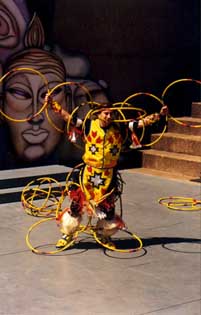 (c) Gary Abbott - www.hoopdance.net
(c) Gary Abbott - www.hoopdance.net
The dancers
create the story of how Mother Earth is connected with all living things.
They step with the beat of the drum and imitate creatures wih dozens of hoops.
They always turn while dancing, which symbolizes the sacred hoop.
Some dancers
use the movements and the form of creatures to put more action into the performance.

9.8.
Intertribal Dance

It
is a dance for everyone, even spectators and tourists because you don't need
regalia. You
can find everyone in the arena, men and women, grass, jingle,
traditional and fancy. Also there are all ages dancing.
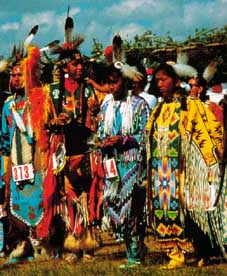 (c) M.Dixon, V.Krasemann
(c) M.Dixon, V.Krasemann

Top
of the page
 A
Pow Wow is
an
experience!
A
Pow Wow is
an
experience!
![]()
![]()
![]()
![]()


 example for a
bustle, (c) M.Dixon, V.Krasemann
example for a
bustle, (c) M.Dixon, V.Krasemann


